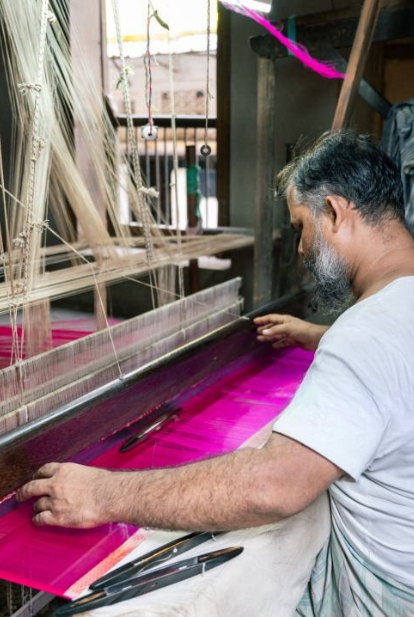10 Reasons Why Millennials & Gen Z Are Switching to Handloom
 A Glimpse into History: Where Handloom Began
A Glimpse into History: Where Handloom Began
Long before fast fashion took over, clothing was made with patience and purpose. Handloom weaving dates back thousands of years, with roots in ancient India, where artisans crafted fabrics by hand—each thread telling a story of culture and craftsmanship.
But as factories rose, handloom faded… until now.
Today, Millennials and Gen Z are bringing handloom back, not just as a trend, but as a movement—one that values ethics, sustainability, and individuality, Here’s why.
1. Sustainability Isn’t a Choice It’s a Necessity
Fast fashion is drowning the planet in waste. Handloom offers a guilt-free alternative:

✔ Zero carbon footprint (woven by hand, no machines)
✔ Biodegradable fabrics (organic cotton, linen, hemp)
✔ Slow fashion mindset (buy less, wear longer)
Weavehand’s Touch: Every piece is made with natural dyes and eco-friendly processes.
2. Unique Style > Mass-Produced Sameness
Gen Z hates looking like everyone else. Handloom guarantees:

One-of-a-kind designs (no two handwoven pieces are identical)
Artisan-made textures (think raw silk, slub cotton, and subtle imperfections that add charm)
Vintage-meets-modern vibes (perfect for #OOTD culture)
3. Ethical Fashion No Exploitation
Millennials demand transparency, Handloom ensures:

Fair wages for weavers (no sweatshops)
Safe working conditions (unlike fast fashion factories)
Supports rural artisans (keeping traditions alive)
Weavehand’s Mission: We work directly with women weavers, empowering them with fair income.
4. Comfort That Doesn’t Compromise
Handloom fabrics are:

Breathable (perfect for hot climates)
Softens with time (unlike stiff, synthetic fabrics)
Lightweight yet durable (ideal for daily wear)
5. Instagram-Worthy & Conscious
Handloom fits the #SustainableFashion aesthetic Gen Z loves:

Earthy tones & natural textures (hello, Pinterest boards!)
Handcrafted details (think tassels, block prints, and embroidery)
Story-driven (post a reel about the artisan who made your kurta!)
6. Budget-Friendly in the Long Run
While handloom may seem pricier upfront, it:

Lasts years (not just a season)
Saves money over time (no need to keep replacing cheap clothes)
Holds value (some pieces become heirlooms!)
7. Cultural Pride & Global Appeal
Gen Z embraces rooted yet global fashion. Handloom offers:

Heritage weaves (like Ikkat, Jamdani, and Chanderi)
Modern silhouettes (handloom shirts, dresses, and co-ords)
Conversation starters (“Where’d you get that?”)
8. Easy to Style for Any Occasion
Handloom isn’t just for traditional wear, Try:
Office looks: Pair a handloom shirt with tailored pants.
Casual outings: Throw on a handwoven scarf with jeans.
Weddings: Opt for a handloom silk saree with minimalist jewelry.
9. Supports Slow Fashion Movement
Millennials and Gen Z are done with disposable fashion, Handloom aligns with:

Minimalist wardrobes (fewer, better pieces)
DIY culture (upcycling handloom scraps into accessories)
Anti-trend mindset (wear what you love, not what’s “in”)
10. It’s a Statement Against Fast Fashion
Every handloom purchase says:

“I care about the planet.”
“I value people over profit.”
“I choose quality over quantity.”
Final Thought: Handloom Isn’t Going Anywhere
 This isn’t just a trend—it’s a revolution. And brands like Weavehand are making it easier than ever to join.
This isn’t just a trend—it’s a revolution. And brands like Weavehand are making it easier than ever to join.
Ready to switch? Explore Weavehand’s handloom collection and wear your values with pride.




